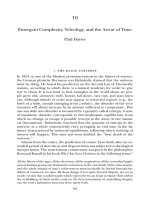Executive summary taming organisational complexity
Bạn đang xem bản rút gọn của tài liệu. Xem và tải ngay bản đầy đủ của tài liệu tại đây (315.92 KB, 6 trang )
A report from The Economist Intelligence Unit
EXECUTIVE SUMMARY:
TAMING
ORGANISATIONAL
COMPLEXITY—
START AT THE TOP
Sponsored by
Taming organisational complexity
About this
research
Taming organisational complexity—start at the top
examines the sources of complexity, its effects and
the efforts companies have undertaken to reduce
it. The report is written by The Economist
Intelligence Unit (EIU) and sponsored by SAP.
The work is based on a survey of 331 executives
conducted in July and August, 2015. Respondents
were drawn from a range of industries, including
13% from financial services and 11% from each of
IT and manufacturing. Thirty-two percent were
from companies with annual revenue of $10b or
1
© The Economist Intelligence Unit Limited 2015
more; 19% from companies with annual revenue of
$5b-$10b; 31% from companies with annual
revenue of $1b-$5b; and 18% from companies with
annual revenue of $500m to $1b. On a regional
basis, 16% of respondents were from China; 20%
from the rest of Asia; 33% from Europe and the
Middle East; 15% from North America; and 16%
from Latin America.
This report was written by Scott Leff and Rodd
Zolkos and edited by Josselyn Simpson.
Taming organisational complexity
Executive summary:
taming organisational complexity—
start at the top
At many companies, organisational complexity is a
recurring challenge for management, impedes
competitiveness and lowers employee morale and
retention. Indeed, in a recent survey of executives
at large companies around the world, conducted by
the Economist Intelligence Unit (EIU), more than
half say complexity has cut into their profits over
the past three years. Furthermore, 38% of all
respondents report that managing complexity
occupied 16-25% of their time—time that could
have been spent on more productive pursuits—with
17% spending a whopping 26-50% of their
workday dealing with complexity. If executives
could cut the time they spend managing
complexity in half, we estimate that a minimum of
8.6m hours a week could be saved by executives in
the US alone—or 45 minutes for every executive
every day1.
In a remarkable comment on the difficulty of
addressing complexity, 8% of respondents say that
their company deliberately slowed growth in an
effort to reduce complexity. Most had tried a range
of other tactics, but reported no more than
moderate success.
Where respondents do report success,
leadership seems to be the key. The survey findings
1 Based on a weighted average of responses to the EIU survey
question “About what percentage of your own time do you spend
managing complexity that you could spend more productively?” and
US Bureau of Labor statistics on average hours worked by all US
workers on private, non-farm payrolls in July 2015 (.
gov/news.release/empsit.t18.htm) and on the number of “top
executives” in the US ( />top-executives.htm).
2
© The Economist Intelligence Unit Limited 2015
suggest that leaders who can make the case for
taming complexity throughout their organisations
and drive adoption of the appropriate tactics for
doing so will be best-positioned to reduce
complexity’s impact and increase productivity and
collaboration.
Complexity is ubiquitous
To shed some light on the causes of and solutions
to organisational complexity, the EIU surveyed 331
executives from companies with annual revenue
greater than $500m in a variety of industries. The
survey, sponsored by SAP, was conducted in July
and August 2015.
Degree of complexity and difficulty of getting
things done
(Percentage of respondents in each category)
Very or
extremely
complex
Not very
complex or
not complex
Very or
somewhat
difficult to get
things done
44%
2%
Somewhat or
very easy to get
things done
5%
7%
Source: Economist Intelligence Unit survey, 2015
Taming organisational complexity
The findings reveal that complexity is a common
feature among large companies, with 55% of
respondents saying that their organisational
structure is extremely or very complex. (Only 1% of
respondents indicate that their organisational
structure is not complex at all.) However, a slightly
smaller 44% of respondents say their company is
very or extremely complex and that it is very or
somewhat difficult to get things done.
Perhaps not surprisingly, the survey also
suggests a link between size of an organisation and
its level of complexity, with a high of 68% of
respondents at companies with more than $5bn in
annual revenue describing their organisation as
extremely or very complex. Further, the number of
countries in which a company operates clearly
relates to greater complexity, again reaching a
high of 67% of respondents at companies with
operations in 50 or more countries saying their
organisation is extremely or very complex. Among
industries, respondents in IT and technology more
often than others describe their organisation as
extremely or very complex.
Complexity’s sources and effects
While the causes of complexity vary greatly, those
most often mentioned by executives are complex
decision-making processes (12%) and
organisational structure (9%).
Regardless of the source, complexity has a direct
impact on the bottom line, respondents say.
Fifty-five percent indicate that over the past three
years complexity has cut into their organisation’s
profits, with 5% saying that profits were affected
significantly.
Areas of the organisation most negatively
affected by complexity, according to executives,
include general management (29%), employee
relations (23%), customer service (21%),
3
© The Economist Intelligence Unit Limited 2015
governance and compliance (19%) and product
development (18%). It’s notable that the two areas
most frequently cited are not externally facing,
perhaps suggesting one reason that complexity can
be put on a back burner.
And all that doesn’t include the toll on individual
executives, 22% of whom say they’re spending at
least one-quarter of their time managing
complexity instead of on more productive tasks. In
the US, for example, cutting the time wasted by all
executives by half would result in reducing wasted
hours for each private-company employee each
week from at least 7.5 to 3.7 hours. Given the
number of top executives in the US, that equals a
minimum of 8.6m hours that could be saved each
week—or 447 million hours a year.
Trying to tame complexity
Given complexity’s widespread impact, companies
report taking a variety of steps to reduce it. Among
the most common are promoting a culture of
collaboration (39%) and implementing new
technology tools or infrastructure (33%). Also
cited were creating cross-functional roles to
facilitate collaboration, adopting new decisionmaking processes and improving leadership
skills—each chosen by 30% of respondents.
But, for the most part, a majority of respondents
from the firms that had tried each of these
strategies found them to be not entirely successful.
Among those businesses that created crossfunctional roles to facilitate collaboration, for
example, only 56% of respondents say doing so
was most helpful, the highest share of any
strategy. Other actions found to be most successful
include implementing new decision-making
processes and implementing new technology tools
or infrastructure (each at 54%).
The primary benefits of all efforts to reduce
Taming organisational complexity
Please estimate how much more productive your company could be overall if you were able to cut
your organisational complexity by half.
Select one.
(% respondents)
Less than 10% more productive
16
11-25% more productive
52
26-50% more productive
More than 50% more productive
19
5
Don’t know
8
Source: Economist Intelligence Unit survey, 2015
complexity, respondents say, include more
efficient decision-making (51%), increased
collaboration (48%) and improved customer
satisfaction (30%).
Many efforts to reduce complexity are ultimately
unsuccessful—9% of respondents report that none
of the methods they had deployed proved to be
helpful. The most commonly cited reasons for
failure are poor management, a culture resistant to
change, a lack of buy-in across the enterprise and
too much data or information to manage.
The case for confronting complexity
continuously
Cover: Shutterstock
In addition to the millions of hours executives could
save by cutting down the time they spend managing
complexity, survey respondents estimated how
much reducing complexity could help their
companies: just over half indicate that if they could
just cut complexity in half, their companies would
be at least 11-25% more productive.
This again highlights the importance of leaders
making reducing complexity a priority and
devoting real time to it.
The survey suggests that leadership decisions on
structure and processes, along with follow-through
on those decisions, are key and that a failure of
leadership or role-modelling likely lies behind
many unsuccessful efforts to reduce complexity (as
in many unsuccessful efforts to manage change of
any kind).
So, the effort to reduce complexity must be
driven from the top down, with executive
management leading the charge by promoting a
culture that favours collaboration and then
providing the tools and technologies that enable
it. Because no effort can be successful without the
ability to measure its impact, it’s necessary to
determine metrics that are appropriate for the
organisation to gauge success. Finally, leaders
need to ensure that reducing complexity remains a
priority for everyone, with sound change
management ensuring that initial efforts to reduce
complexity take root and thrive.
Whilst every effort has been taken to verify the accuracy of this information, neither The Economist Intelligence Unit Ltd. nor the sponsor of this report can accept
any responsibility or liability for reliance by any person on this report or any of the information, opinions or conclusions set out in the report.
4
© The Economist Intelligence Unit Limited 2015
London
20 Cabot Square
London
E14 4QW
United Kingdom
Tel: (44.20) 7576 8000
Fax: (44.20) 7576 8476
E-mail:
New York
750 Third Avenue
5th Floor
New York, NY 10017
United States
Tel: (1.212) 554 0600
Fax: (1.212) 586 0248
E-mail:
Hong Kong
1301 Cityplaza Four
12 Taikoo Wan Road
Taikoo Shing
Hong Kong
Tel: (852) 2585 3888
Fax: (852) 2802 7638
E-mail: :
Geneva
Boulevard des
Tranchées 16
1206 Geneva
Switzerland
Tel: (41) 22 566 2470
Fax: (41) 22 346 93 47
E-mail:









